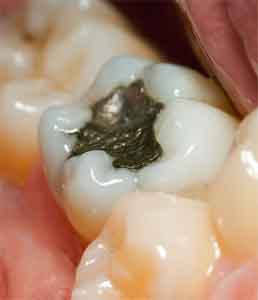Over the last few weeks, the Baseline of Health Foundation has received a burst of comments and emails espousing extreme positions contrary to those we have published online. Under my direction, the Foundation staff has responded to these queries with reasoned arguments that addressed all of the key points raised in the original notes. Surprisingly (or not surprisingly, depending on your point of view), this made no difference. Follow up emails by the queriers demonstrated that our response had merely made them deny all logic and dig in deeper.
And then it occurred to me: does something similar happen in the world of “scientific” medicine when deeply ingrained beliefs (e.g. flu shots, statin drugs, antidepressants, hormone replacement therapy, fluoridated water, and amalgam fillings) are challenged? Does that mean that no matter how much evidence you present to the contrary, you are merely reinforcing the original mistaken belief for a large number of doctors? And if that’s true, why does it happen, and is there anything you can do about it?
Bred in the bone
My first stop took me to a blog I had written last December concerning a study out of the University of California San Diego and Harvard University that found that there is definitely a genetic factor to our political leanings. Specifically, the study found that:
- Our political positions are not determined by logical analysis, but, for the most part, by biology.
- “These views are deep-seated and built into our brains. Trying to persuade someone not to be liberal is like trying to persuade someone not to have brown eyes.” In other words, we have to rethink persuasion.
This study is significant because it illuminates the fact that fixity of position, at least in some cases, may actually be hardwired into us — either in our DNA or in our social programming — thus rendering those positions untouchable by logical argument. But the study is very explicit in addressing only liberal/conservative inclinations. When it comes to health, rigid illogical positions can be held by people of all political stripes — liberal, conservative, educated, or intuitive. Therefore, although fascinating and undoubtedly related, this study does not directly apply to the kinds of rigidity I have been seeing lately.
I needed to keep looking.
Mother Jones
My next stop took me to an article entitled The Science of Why We Don’t Believe Science by Chris Mooney in Mother Jones1Chris Mooney. “The Science of Why We Don’t Believe Science.” Mother Jones. May/June 2011 Issue (Accessed 28 June 2011.) <http://motherjones.com/politics/2011/03/denial-science-chris-mooney> magazine. Amusingly, the article’s title announces its own bias. That is, if something is stated in the name of science, it is, by definition, worthy of unquestioned belief. Ahh! If only life were that simple; and in fact, we’re going to be addressing this issue in detail in a few minutes. Nevertheless, as long as you are aware of the article’s inherent bias going in, then there is much to be gleaned from it.
Mooney begins his article with a quote from renowned Stanford University psychologist, Leon Festinger: “A man with a conviction is a hard man to change. Tell him you disagree and he turns away. Show him facts or figures and he questions your sources. Appeal to logic and he fails to see your point.” This sounds like a perfect description of the situations I’ve been finding myself in repeatedly over the last few weeks. So far so good; let’s continue.
 Mooney then continues by describing one of Dr. Festinger’s most famous case studies — his infiltration of a Chicago based doomsday cult during the mid-1950’s. Festinger and several of his colleagues had managed to befriend The Seekers, a small (approximately 30-person) Chicago-area cult whose members believed they were communicating with a group of aliens called The Guardians — one of whom was the most recent incarnation of Jesus. The group was led by a physician on the staff of a college student health service (who provided credibility to the group) and a woman who was recognized as a respected authority on matters occult and mystical. The aliens communicated through her via automatic writing.
Mooney then continues by describing one of Dr. Festinger’s most famous case studies — his infiltration of a Chicago based doomsday cult during the mid-1950’s. Festinger and several of his colleagues had managed to befriend The Seekers, a small (approximately 30-person) Chicago-area cult whose members believed they were communicating with a group of aliens called The Guardians — one of whom was the most recent incarnation of Jesus. The group was led by a physician on the staff of a college student health service (who provided credibility to the group) and a woman who was recognized as a respected authority on matters occult and mystical. The aliens communicated through her via automatic writing.
And it was, in fact, through these writings that the aliens had given the precise date of an earth-ending, cataclysmic flood that was supposed to take place on December 21, 1954. Although the members of the group were at first alarmed by this prediction of their doom, further communications assured them that they, and those who believed in their teachings, would be rescued and taken to a place of safety in flying saucers the evening before the end of the world. Some of the group were so convinced that doomsday was at hand that they quit their jobs and sold their property, expecting to be rescued and taken away from it all when the earth was swallowed in the predicted disaster.
Festinger and his team were with the group when the prophecy fell apart. First, no flying saucers came to rescue them on judgment day eve. This, of course, was unnerving for the members of the group. But then judgment day itself arrived (and passed) without incident. It was the moment the researchers had come to study: How would people so emotionally invested in a belief system react, now that it had been clearly shown to be false?
As Mooney explains in his article, “At first, the group struggled for an explanation. But then rationalization set in. A new message arrived, announcing that they’d all been spared at the last minute. Festinger summarized the extraterrestrials’ new pronouncement: ‘The little group, sitting all night long, had spread so much light that God had saved the world from destruction.’ Their willingness to believe in the prophecy had saved Earth from the prophecy!
“From that day forward, The Seekers, previously shy of the press and indifferent toward evangelizing, began to proselytize. ‘Their sense of urgency was enormous,’ wrote Festinger. The devastation of all they had believed had made them even more certain of their beliefs.”
This was it. This was exactly what I had been experiencing. It didn’t matter how I or the Foundation staff answered the questions we had been receiving, or how well we had methodically refuted the inconsistencies in the questioners’ logic; it only caused them to dig in deeper and become even more convinced than ever that they were right. Unfortunately, although Festinger and Mooney did a great job describing the event, they were less effective at explaining why it happened in the first place. Mooney, for example, put it down to rationalizing — a pretty generic and non-informative explanation. No, if I wanted to understand why, I had to look elsewhere.
Cialdini
 About a quarter of a century ago (updated several times since then), Robert Cialdini wrote a bestseller entitled, Influence: the Psychology of Persuasion.2Robert B. Cialdini, PH.D, Influence: the Psychology of Persuasion (New York: Collins Business, 2007), 58–59. <http://www.amazon.com/Influence-Psychology-Persuasion-Business-Essentials/dp/006124189X/ref=sr_1_1?ie=UTF8&qid=1309566075&sr=8-1> The great thing about Cialdini’s book is that it not only illustrates the whole gamut of responses and opinions that are hardwired into us, it also explores the whys. In fact, Cialdini explores the Festinger example in considerably more detail than Mooney.3Ibid 120-128. But of more interest to me at this particular time was Cialdini’s example concerning his neighbor, Sara and her live-in boyfriend, Tim.4Ibid 58-59. Tim was an X-ray technician and Sara was a nutritionist. They met at the hospital where they both worked — then dated and moved in together after Tim lost his job. Sara was very attached to Tim despite the fact that he was no longer working and drank heavily. Eventually, though, Sara broke things off when Tim refused to change either position. Tim moved out, and Sara began seeing an old boyfriend who was everything Tim was not. In fact, Sara and her old boyfriend got engaged, set a date, and even mailed out invitations to the wedding.
About a quarter of a century ago (updated several times since then), Robert Cialdini wrote a bestseller entitled, Influence: the Psychology of Persuasion.2Robert B. Cialdini, PH.D, Influence: the Psychology of Persuasion (New York: Collins Business, 2007), 58–59. <http://www.amazon.com/Influence-Psychology-Persuasion-Business-Essentials/dp/006124189X/ref=sr_1_1?ie=UTF8&qid=1309566075&sr=8-1> The great thing about Cialdini’s book is that it not only illustrates the whole gamut of responses and opinions that are hardwired into us, it also explores the whys. In fact, Cialdini explores the Festinger example in considerably more detail than Mooney.3Ibid 120-128. But of more interest to me at this particular time was Cialdini’s example concerning his neighbor, Sara and her live-in boyfriend, Tim.4Ibid 58-59. Tim was an X-ray technician and Sara was a nutritionist. They met at the hospital where they both worked — then dated and moved in together after Tim lost his job. Sara was very attached to Tim despite the fact that he was no longer working and drank heavily. Eventually, though, Sara broke things off when Tim refused to change either position. Tim moved out, and Sara began seeing an old boyfriend who was everything Tim was not. In fact, Sara and her old boyfriend got engaged, set a date, and even mailed out invitations to the wedding.
And then a repentant Tim called. He begged Sara to cancel her wedding plans and take him back so they could live together as before. At first Sara refused, saying that she couldn’t live with Tim’s drinking and lack of commitment. Even when Tim offered to marry her, she told him she preferred her fiancé. It wasn’t until Tim promised to also quit drinking if she took him back that Sara relented, canceled her wedding, and let Tim move back in with her.
Surprise! Surprise! Surprise! Shortly after moving back in, Tim told Sara that he didn’t think he really needed to quit drinking and that it would be best if they waited awhile to see how things worked out before even thinking about getting married. Two years passed and nothing had changed. Tim and Sara were still living together; Tim still drank; and there were still no marriage plans.
Okay, so you’re not surprised; you guessed that this was going to happen. Good call.
But hold onto your socks, because there is a huge surprise here. According to Cialdini, Sara has no regrets! She is more devoted to Tim than ever and tells everyone that being forced to choose taught her that Tim really is the love of her life. Astoundingly, she is even happier with Tim — even though he reneged on every promise and nothing has changed. Voila! This is exactly what I have been experiencing recently with the emails and comments coming into the Foundation. But why?
And it is here that Cialdini nails the answer: “Indeed, we all fool ourselves from time to time in order to keep our thoughts and beliefs consistent with what we have already done or decided.” This is called the consistency principle. “Once we have made a choice or taken a stand, we will encounter personal and interpersonal pressures to behave consistently with that commitment. Those pressures will cause us to respond in ways that justify our earlier decision.”
How doctors fool themselves
As Cialdini points out, the consistency principle is hardwired into us. In most circumstances, consistency is a valued social trait. A high degree of personal consistency is usually associated with personal and intellectual strength. Lack of consistency, on the other hand, is often perceived as indecisiveness, being confused, two-facedness, and even mental illness. In addition, consistency makes life easier. Once we have navigated our way through an issue, stubborn consistency allows us to “not think about the issue” anymore. We no longer have to sort through information or weigh pros and cons. We can simply act consistent with our earlier decision and expend our energy thinking about “new” things. And most of the time, this actually works quite well for us. It only becomes a problem when we stubbornly lock into an erroneous position — like Sara.
Flu shots
 If you listen to your doctor or the mainstream media (which gets its health information from the medical community), you are likely to believe that flu vaccines work — no question about it. You would probably believe, as do most doctors, that the benefits of flu vaccines have been studied, proven, and written up in countless peer-reviewed journals. You would probably also believe that any opinions to the contrary come only from fanatics (or members of The Seekers) — who cannot be convinced, no matter what evidence you present to them. Sara on steroids — if you will! But if that is what you thought, you would be mistaken.
If you listen to your doctor or the mainstream media (which gets its health information from the medical community), you are likely to believe that flu vaccines work — no question about it. You would probably believe, as do most doctors, that the benefits of flu vaccines have been studied, proven, and written up in countless peer-reviewed journals. You would probably also believe that any opinions to the contrary come only from fanatics (or members of The Seekers) — who cannot be convinced, no matter what evidence you present to them. Sara on steroids — if you will! But if that is what you thought, you would be mistaken.
In fact, exactly the opposite is true.
There have actually been very few studies analyzing the effectiveness of flu vaccines, and the results have been quite mixed. In fact, the vast majority of support for flu vaccines in the medical community is based on one single set of studies, the Cohort Studies on the effectiveness of the seasonal flu vaccine. These studies found a 50-90% effectiveness rate for the vaccine and are cited as gospel by doctors all over the world and by medical experts on television. However, even a casual examination of these studies reveals their absurdity. (It should be noted that probably over 90% of the doctors who cite these studies have never actually read them. They merely parrot the results they have heard second, third, and fourth hand.)The Atlantic Monthly5Shannon Brownlee and Jeanne Lenzer. “Does the Vaccine Matter?” The Atlantic. November 2009. Accessed 7 July 2011.<http://www.theatlantic.com/magazine/archive/2009/11/does-the-vaccine-matter/7723/> wrote a great article eviscerating them. Their conclusion is that the flu vaccine Cohort Studies are rendered irrelevant by the bias of the cohort selection. Consider:
- Because it’s virtually impossible to identify who has the flu and who doesn’t, the researchers identified their cohort as those who died from all causes (flu, coronary events, lightning strikes, accidents, whatever) and then broke that into two: those who received the flu vaccine and those who didn’t. Choosing the cohort as deaths from all causes introduces a bias into the study. To be fair, the researchers figured that any difference in outcomes between those who had the flu vaccine and those who didn’t would by definition sort itself out and be the result of the flu vaccine alone since lightning strikes would obviously be the same in both groups. Unfortunately, what is obvious is not necessarily true. In the end, you have to be absolutely blind to miss the anomalies once you look at the published results. What were these results? These studies show a “dramatic difference” between the death rates of those who get the vaccine VS those who don’t (50-90% less depending on the study cited). And therein lies the problem.
- According to the National Institute of Allergy and Infectious Diseases, deaths from influenza account for — at most — 10 percent of total deaths during the flu season. Nevertheless, the Cohort Studies found that receiving a flu vaccine reduced total deaths by 50 percent — five times the total number of flu deaths. That’s one amazing vaccine!
- To put this in perspective, according to Dr. Tom Jefferson of the Cochrane Collaboration, “For a vaccine to reduce mortality by 50 percent, and up to 90 percent in some studies, means it has to prevent deaths not just from influenza, but also from falls, fires, heart disease, strokes, and car accidents. That’s not a vaccine, that’s a miracle.”
- And as icing on the cake, there was also no difference in mortality rates based on whether the deaths occurred in flu season or out of it. Truly, a miraculous vaccine!
So is there any valid conclusion that we can make from the flu vaccine Cohort Studies? Probably! Since people taking the vaccine had fewer heart attacks, deaths by accident, lightning strikes, etc. (but not necessarily from the flu itself), we can probably conclude that people who choose to get vaccinated are likely to be more health and safety conscious than those who don’t — and thus avoid dangerous situations and risks. But as far as the primary purpose of the studies, the efficacy of the flu vaccine, no conclusions can be made because of the bias introduced into the study by the flawed cohort selection of people who died from all causes.
And yet, it is this absurdly flawed set of studies that virtually every physician hangs their hat on when promoting the efficacy of flu vaccines — even if they themselves have never read them. Why?
They endorse flu vaccines because it is consistent with everything they have been taught about vaccines and everything they have heard, second and third hand, from their peers. It is not necessarily true, but it is consistent — and it is socially acceptable within the medical community. In fact, to be inconsistent and disagree would get you labeled a quack.
Statin drugs
Statin drugs are another great myth that doctors buy into en masse, even when conclusive data proves they don’t work except in very limited circumstances. And what’s worse, they are nowhere near as safe as promoted.
 For a long time, scientists have known that cholesterol-regulating drugs can cause structural damage to muscles. But they were convinced that it only affected a small number of people. Maybe ten to fifteen percent of patients develop muscle pain and weakness, but after they stop using the drugs, only one in 50 report continual or debilitating pain. In fact, this is the “rare but serious muscle side effect” that is quickly mentioned at the end of Lipitor ads.>6Lipitor. Accessed 3 July 2011. http://www.lipitor.com/ But more recent studies have found that these side effects are anything but rare. A 2009 Canadian Medical Association Journal study found that the standard CPK test used by doctors to establish muscle damage is highly inaccurate and dramatically underestimates the scope of the problem.7Markus G. Mohaupt MD, Richard H. Karas MD PhD, Eduard B. Babiychuk PhD, et al. “Association between statin-associated myopathy and skeletal muscle damage.” CMAJ July 7, 2009 vol. 181 no. 1-2 E11-E18. <http://www.cmaj.ca/content/181/1-2/E11.full.pdf+html> In fact, the Canadian study found that more than half of all people who use statin drugs show structural damage to muscle fibers when more accurate biopsy analysis is used. Fifty percent, by the way, does not qualify as “rare.” And even that may underestimate the problem. According to a 2006 study published in the Journal of Pathology, virtually all patients who take statin drugs experience muscle damage, even if they don’t have pain.8A Draeger, K Monastyrskaya, M Mohaupt, H Hoppeler, H Savolainen, C Allemann, EB Babiychuk. “Statin therapy induces ultrastructural damage in skeletal muscle in patients without myalgia.” The Journal of Pathology. September 2006 Volume 210, Issue 1, pages 94-102. <http://onlinelibrary.wiley.com/doi/10.1002/path.2018/abstract> And yet doctors continue to hold onto the myth that statin drugs are relatively free of side effects. As a side note, supplementing with CoQ10 will eliminate most of the muscle damage.9Caso G, et al. Effect of coenzyme q10 on myopathic symptoms in patients treated with statins. Am J Cardiol. 2007 May 15;99(10):1409-12.<http://www.ncbi.nlm.nih.gov/pubmed/17493470>,10Silver MA, Langsjoen PH, Szabo S, Patil H, Zelinger A. Effect of atorvastatin on left ventricular diastolic function and ability of coenzyme Q10 to reverse that dysfunction. Am J Cardiol. 2004 Nov 15;94(10):1306-10. And as a further side note, if your doctor recommends using statin drugs and does not insist that you also supplement with CoQ10, then you might want to consider finding another doctor.
For a long time, scientists have known that cholesterol-regulating drugs can cause structural damage to muscles. But they were convinced that it only affected a small number of people. Maybe ten to fifteen percent of patients develop muscle pain and weakness, but after they stop using the drugs, only one in 50 report continual or debilitating pain. In fact, this is the “rare but serious muscle side effect” that is quickly mentioned at the end of Lipitor ads.>6Lipitor. Accessed 3 July 2011. http://www.lipitor.com/ But more recent studies have found that these side effects are anything but rare. A 2009 Canadian Medical Association Journal study found that the standard CPK test used by doctors to establish muscle damage is highly inaccurate and dramatically underestimates the scope of the problem.7Markus G. Mohaupt MD, Richard H. Karas MD PhD, Eduard B. Babiychuk PhD, et al. “Association between statin-associated myopathy and skeletal muscle damage.” CMAJ July 7, 2009 vol. 181 no. 1-2 E11-E18. <http://www.cmaj.ca/content/181/1-2/E11.full.pdf+html> In fact, the Canadian study found that more than half of all people who use statin drugs show structural damage to muscle fibers when more accurate biopsy analysis is used. Fifty percent, by the way, does not qualify as “rare.” And even that may underestimate the problem. According to a 2006 study published in the Journal of Pathology, virtually all patients who take statin drugs experience muscle damage, even if they don’t have pain.8A Draeger, K Monastyrskaya, M Mohaupt, H Hoppeler, H Savolainen, C Allemann, EB Babiychuk. “Statin therapy induces ultrastructural damage in skeletal muscle in patients without myalgia.” The Journal of Pathology. September 2006 Volume 210, Issue 1, pages 94-102. <http://onlinelibrary.wiley.com/doi/10.1002/path.2018/abstract> And yet doctors continue to hold onto the myth that statin drugs are relatively free of side effects. As a side note, supplementing with CoQ10 will eliminate most of the muscle damage.9Caso G, et al. Effect of coenzyme q10 on myopathic symptoms in patients treated with statins. Am J Cardiol. 2007 May 15;99(10):1409-12.<http://www.ncbi.nlm.nih.gov/pubmed/17493470>,10Silver MA, Langsjoen PH, Szabo S, Patil H, Zelinger A. Effect of atorvastatin on left ventricular diastolic function and ability of coenzyme Q10 to reverse that dysfunction. Am J Cardiol. 2004 Nov 15;94(10):1306-10. And as a further side note, if your doctor recommends using statin drugs and does not insist that you also supplement with CoQ10, then you might want to consider finding another doctor.
But muscle damage is not the biggest problem with statin drugs — nor connected with the biggest myth doctors have bought into. A study sponsored by Merck and Schering-Plough, the manufacturer of Vytorin, found that after several years on two types of cholesterol-lowering medications, patients did indeed reduce their cholesterol levels, but they reaped no significant health benefit at all unless they already had heart disease. The bottom line is that unless you have already had a heart attack, statin drugs will not provide a single health benefit; they will not extend your life one single day.
And yet doctors continue to prescribe them like candy. In fact, in 2010, AstraZeneca received permission from the FDA to sell its statin drug, Crestor, as a “preventative” measure to an additional 6.5 million people — none of whom actually have cholesterol or heart problems. That’s right, the FDA authorized doctors to pitch you a solution that doesn’t work, that causes muscle damage to virtually everyone using it — just as a preventative…that doesn’t actually prevent anything. And the medical community accuses the alternative health community of not being science based!!?? In any case, I think it’s safe to say that Sara would understand.
Antidepressants
Antidepressants are now the third most commonly prescribed drugs in the US, at 120 million prescriptions a year — right behind pain relievers, and statin drugs.11Schappert SM, Rechtsteiner EA. Ambulatory medical care utilization estimates for 2007. National Center for Health Statistics. Vital Health Stat 13(169). 2011. http://www.cdc.gov/nchs/data/series/sr_13/sr13_169.pdf While some doctors maintain that genuine depression is driving the prescription numbers, more rational doctors point out that the real force behind skyrocketing antidepressant prescription rates is pharmaceutical marketing to doctors and to consumers. And it seems the New England Journal of Medicine agrees with the naysayers. According to an article published in 2008, the press on antidepressants hasn’t presented an accurate picture. Of the 74 antidepressant studies submitted to the FDA between 1987 and 2004, only 38 were “positive.” The remaining studies found that antidepressants, in fact, did nothing to relieve depression.12Unknown. “Antidepressants may not work – report.” 16 January 2011. CNNMoney. Accessed 3 July 2011. <http://money.cnn.com/2008/01/16/news/companies/antidepressants/index.htm> Zip. Nada. Zilch. Ultimately, even the positive studies tended to find that the drugs worked only for the most severely depressed patients.
In fact, recent studies have confirmed that simple exercise works as well, or better, than pharmaceutical drugs at relieving depression. And yet, current sales of antidepressant drugs net over $11 billion worldwide and climbing, with sales in the US comprising 71 percent of that figure.1312 Unknown. “Antidepressant Drug Market.” Accessed 3 July 2011. Wikninvest. <http://www.wikinvest.com/concept/Antidepressant_Drug_Market> Substitute alcohol for pharmaceutical drugs and Tim would be fully simpatico.
Hormone replacement therapy
Hormone replacement therapy (HRT) has been thoroughly discredited. Its use has been associated with a doubling of your risk of breast cancer, while offering only a temporary reprieve from osteoporosis. The problem is that bone loss accelerates rapidly in women once they stop using estrogen, causing a “catch-up” effect. By age 80, women who had taken HRT for 10 years and then stopped for 10 years would lose 27 percent of their initial bone density, while those who were never treated would lose about 30 percent. The only way you would get continued benefit is take HRT for the rest of your life, which would likely be shorter because of the increased risk of developing breast and endometrial cancer. Bottom line: HRT doesn’t build bone; it only puts off when that loss occurs and at great risk.
 Another benefit ascribed to HRT is the prevention of heart disease — based on the simplistic observation that women on HRT have less heart disease. Unfortunately, this has turned out to be due to the lifestyles of women who take HRT, rather than the medical benefits of HRT itself. More recent studies of women, such as the Heart and Estrogen/Progestin Replacement Study (HERS) and the Women’s Health Initiative (WHI) concluded that overall health risks exceeded the benefits provided by HRT. Women who participated in the WHI showed a 26% increased risk of breast cancer, a 29% increased risk of coronary heart disease (including nonfatal heart attacks), and a 41% increased risk of stroke.14Writing Group for the Women’s Health Initiative Investigators: Risks and benefits of estrogen plus progestin in healthy menopausal women. Principal results from the Women’s Health Initiative randomized controlled trial. JAMA 2002; 288:321-333. < http://jama.ama-assn.org/content/288/3/321.full>
Another benefit ascribed to HRT is the prevention of heart disease — based on the simplistic observation that women on HRT have less heart disease. Unfortunately, this has turned out to be due to the lifestyles of women who take HRT, rather than the medical benefits of HRT itself. More recent studies of women, such as the Heart and Estrogen/Progestin Replacement Study (HERS) and the Women’s Health Initiative (WHI) concluded that overall health risks exceeded the benefits provided by HRT. Women who participated in the WHI showed a 26% increased risk of breast cancer, a 29% increased risk of coronary heart disease (including nonfatal heart attacks), and a 41% increased risk of stroke.14Writing Group for the Women’s Health Initiative Investigators: Risks and benefits of estrogen plus progestin in healthy menopausal women. Principal results from the Women’s Health Initiative randomized controlled trial. JAMA 2002; 288:321-333. < http://jama.ama-assn.org/content/288/3/321.full>
So, with more and more medical authorities lining up to say that the risks of HRT outweigh the benefits, you would think that no one would be prescribing it anymore. But you would be wrong. Yes, its use is down 50% from its peak, but according to data from a large, continuous survey of physicians, usage is still high. About 3.1 million visits in the U.S. in 2009 resulted in prescriptions for standard-dose estrogen therapy, alone or in combination with other hormones, according to a study published online in Menopause.15Tsai, Sandra A. MD, MPH; Stefanick, Marcia L. PhD; Stafford, Randall S. MD, PhD. “Trends in menopausal hormone therapy use of US office-based physicians, 2000-2009.” Menopause: April 2011 – Volume 18 – Issue 4 – pp 385-392. <http://journals.lww.com/menopausejournal/Abstract/2011/04000/Trends_in_menopausal_hormone_therapy_use_of_US.9.aspx> About one million of those prescriptions were for women 60 and older, the population most at risk for the increased incidence of cardiovascular disease and cancer identified in the Women’s Health Initiative study.
We’re talking deadly consistency from a large number of doctors here.
Fluoridated water
As stated on the ADA Website, “The American Dental Association continues to endorse fluoridation of community water supplies as safe and effective for preventing tooth decay. This support has been the Association’s position since policy was first adopted in 1950. The ADA’s policies regarding community water fluoridation are based on the overwhelming weight of peer-reviewed, credible scientific evidence. The ADA, along with state and local dental societies, continues to work with federal, state and local agencies to increase the number of communities benefiting from water fluoridation.”16Unknown. “Fluoride & Fluoridation.” American Dental Association. Accessed 3 July 2011. <http://www.ada.org/fluoride.aspx>
And yet, although supported by organizations such as the American Dental Association and the American Medical Association, fluoridation is disapproved of by the New England Journal of Medicine, the National Institute of Environmental and Health Sciences, and the EPA. And fluoridated water is banned in Austria, Belgium, China, Czech Republic, Denmark, Finland, Germany, Hungary, India, Israel, Japan, Luxembourg, Norway, Scotland, Sweden, Switzerland, and The Netherlands. More surprisingly, the EPA and National Institute of Environmental and Health Services show evidence that fluoride causes cancer. Other studies have stated that excess fluoride suppresses the immune system, causes mouth, throat and bone cancer, emphysema-like respiratory conditions, skin lesions, liver and kidney damage, neurological disorders, chronic diseases, miscarriages, vision problems, brittle bones, and mottled teeth.
 In 2007 more than 600 professionals urged Congress to stop water fluoridation until Congressional hearings were conducted. They cited new scientific evidence that fluoridation, long promoted to fight tooth decay, is ineffective and has serious health risks.
In 2007 more than 600 professionals urged Congress to stop water fluoridation until Congressional hearings were conducted. They cited new scientific evidence that fluoridation, long promoted to fight tooth decay, is ineffective and has serious health risks.
Supporters included a Nobel Prize winner, three members of the prestigious 2006 National Research Council (NRC) panel that reported on fluoride’s toxicology,17National Research Council Panel. “Fluoride in Drinking Water: A Scientific Review of EPA’s Standards.” The National Academies Press. 2006. < http://www.nap.edu/catalog.php?record_id=11571> two officers in the Union representing professionals at EPA headquarters, the President of the International Society of Doctors for the Environment, and hundreds of medical, dental, academic, scientific and environmental professionals, worldwide.
Dr. Arvid Carlsson, winner of the 2000 Nobel Prize for Medicine, said, “Fluoridation is against all principles of modern pharmacology.” Paul Connett, PhD, Executive Director of the Fluoride Action Network, announced, “The NRC report dramatically changed scientific understanding of fluoride’s health risks. Government officials who continue to promote fluoridation must testify under oath as to why they are ignoring the powerful evidence of harm.”
In 2009, an additional 2,600 professionals urged Congress to stop water fluoridation until Congressional hearings are conducted.
But fluoridation isn’t just about teeth. A second pitch more recently developed in favor of water fluoridation is that it reduces the incidence of hip fractures. What wonderful good fortune that this benefit was discovered when fluoridation to prevent tooth decay was under attack. But in fact, evidence indicates that the exact opposite is true. The confusion comes about because fluoride does indeed collect in the bones, and it does indeed “technically” increase bone mass and density. However, the evidence is very strong that fluoride intake actually makes bones more brittle. Or to put it another way: yes, fluoride increases bone density, but the quality of that new bone is very poor, very brittle. The bottom line is that drinking fluoridated water can actually double the incidence of hip fractures.18Unknown. “Fluoride’s Differential Effect on Bone Density.” Fluoride Action Network. Accessed 3 July 2011. < http://fluoridealert.org/health/bone/density/cortical-trabecular.html> So much for the better bone theory. But even worse, in 2009, research published in Biological Trace Element Research found that drinking fluoridated water is associated with a significantly higher risk of osteosarcoma, aka bone cancer.19James Street. “Fluoride Linked to Bone Cancer, Yet Again.” 14 August 2010. Defeat Osteosarcoma. Accessed 4 July 2011. <http://defeatosteosarcoma.org/2010/08/fluoride-linked-to-bone-cancer-yet-again/> So now the benefit of “better” bones can be viewed more accurately as more brittle bones…and cancerous to boot. And this study was not isolated. It merely confirmed a series of earlier studies that had come to the same conclusion.
More recently, a review of studies published in Neurologia just last month finds, “The prolonged ingestion of fluoride may cause significant damage to health and particularly to the nervous system.”20Paul Beeber. “New Study: Fluoride Can Damage the Brain — Avoid Use in Children.” 21 June 2011. PR Newswire. Accessed 4 July 2011. < http://www.prnewswire.com/news-releases/new-study-fluoride-can-damage-the-brain—avoid-use-in-children-124299299.html>
And yet, the American Dental Association, in the name of consistency, holds steadfastly to its pro fluoridation position, committed to getting it into ever more local water supplies. Like Sara holding onto Tim, they seem more devoted to fluoride by the year — even as community after community abandons the practice.
Amalgam fillings
And while we’re on a roll with the American Dental Association, let’s talk about amalgam fillings. Mercury amalgam fillings offer a textbook case of the inner need for consistency trumping the objective need to be right. The American Dental Association has resolutely maintained for years that “when mercury is combined with the metals used in dental amalgam, its toxic properties are made harmless.” If this were true, it would be miraculously fortuitous. Amalgam, which consists of mercury, silver, tin, copper, and a trace amount of zinc, has been used by dentists for hundreds of years — as far back, actually, as the 7th century in China. In the United States, mercury-based fillings made their appearance in the early 1800s.
 From the beginning, there were a number of dentists who were concerned by the presence of mercury, since by that time it was fairly well known that mercury was poisonous. In fact, these concerns were so strong that by the mid-1940s several dental societies, including the American Society of Dental Surgeons, had joined together to stop the use of amalgam fillings. But amalgam was just too easy to work with, and whatever ill effects people experienced were too far down the road to matter. So, in 1859, the American Dental Association (ADA) was founded primarily to promote the use of mercury amalgam as a safe and desirable tooth filling material. There were no tests done. Amalgam was promoted because it was easy to work with. The reason that mercury is used is because it serves to “dissolve” the other metals and make a homogenous whole.
From the beginning, there were a number of dentists who were concerned by the presence of mercury, since by that time it was fairly well known that mercury was poisonous. In fact, these concerns were so strong that by the mid-1940s several dental societies, including the American Society of Dental Surgeons, had joined together to stop the use of amalgam fillings. But amalgam was just too easy to work with, and whatever ill effects people experienced were too far down the road to matter. So, in 1859, the American Dental Association (ADA) was founded primarily to promote the use of mercury amalgam as a safe and desirable tooth filling material. There were no tests done. Amalgam was promoted because it was easy to work with. The reason that mercury is used is because it serves to “dissolve” the other metals and make a homogenous whole.
It would be miraculous indeed if you could arbitrarily use one of the most toxic substances known with no ill effect. How was this defended? Well, the early position — again untested — was that the mercury reacts with the other metals to form a “biologically inactive substance” so that none of it ever makes its way into your body. This was an interesting theory that, of course, turned out to be false. Numerous studies conducted in the 1970s and 1980s proved conclusively that the mercury from fillings (primarily from mercury vapor created when we chew) makes its way into the body, ending up in our lungs, heart, stomach, kidneys, endocrine glands, gastrointestinal tract, jaw tissue, and our brains. In effect, the denser the tissue, the greater the concentration of mercury. There have been over 12,000 papers published to date elucidating the dangers of amalgam fillings, but the most compelling of those studies detailed the use of radioactively tagged amalgam fillings in a controlled experiment. In less than thirty days, substantial levels of the tagged mercury were found throughout the body and brain, especially in the liver and kidneys. Studies have shown that within a month of receiving amalgam fillings, kidney function is reduced by well over 50 percent.21Boyd, N.D., H. Benediktsson, M.J. Vimy, et al. “Mercury from Dental ‘Silver’ Tooth Fillings Impairs Sheep Kidney Function.” AJP – Regu Physiol. October 1991 vol. 261 no. 4 R1010-R1014.
Once it became irrefutable that mercury from the fillings was ending up in our bodies, the ADA was faced with a choice: come down on the side of reality, or the side of consistency. And like Sara, they chose consistency. It then became mandatory for the ADA to find a new theory to defend their original untenable position. Again, not based on clinical studies but rather on convenience, it became the position of the ADA that, yes, perhaps some mercury does make its way into the body, but at levels that are so low they have no effect on our health.22Unknown. “Dental Filling Facts.” American Dental Association. Accessed 4 July 2011. <http://www.ada.org/sections/publicResources/pdfs/dental_fillings_facts_full.pdf> And once again, it would be miraculous indeed if that were true. Unfortunately, it is not — like so many other toxic substances, the real problem with mercury is that it is a cumulative poison and the body holds onto a significant percentage of the mercury that enters it.
Mercury is one of the most toxic metals known — even more toxic than lead. And while there is no conclusive evidence that the mercury from fillings causes any particular health problems, there are a number of studies that strongly imply such a relationship. There is strong evidence that mercury lowers T-cell (white blood cells) counts. A number of studies have shown removing amalgam fillings can cause T-cell counts to rise anywhere from 50 to 300 percent. This alone implicates amalgam fillings in cancer, autoimmune diseases, allergies, Candida overgrowth, and multiple sclerosis (MS). In fact, there have been several studies that have shown that white blood cell abnormalities, such as found in leukemia, tend to normalize when amalgam fillings are removed. Mercury levels in MS patients are, on average, 7.5 times higher than normal.
It has also been shown that mercury interferes with the ability of the blood to carry oxygen — actually cutting its oxygen-carrying capabilities by half. This would account for many instances of chronic fatigue syndrome. Mercury also has an affinity for brain tissue and is implicated in brain tumors and dementia. The famous “mad hatters” of England were actually hat makers who worked with mercury and eventually went insane. Finally, mercury has an affinity for fetal tissue — reaching higher levels in the fetus than in the mother herself — which accounts for mercury’s implication in birth defects. What about other sources of mercury entering the body as noted by the ADA? Well, seafood, of course, is a source, and some other foods we eat are too, including high fructose corn syrup.23Renee Dufault, Blaise LeBlanc, Roseanne Schnoll, Charles Cornett, Laura Schweitzer, David Wallinga, Jane Hightower, Lyn Patrick, and Walter J Lukiw.”Mercury from chlor-alkali plants: measured concentrations in food product sugar.” Environmental Health 2009, 8:2. <http://www.ehjournal.net/content/8/1/2>, 24David Wallinga, M.D., Janelle Sorensen, Pooja Mottl, Brian Yablon, M.D. “Not So Sweet: Missing Mercury and High Fructose Corn Syrup.” Institute for Agriculture and Trade Policy. January 2009. <http://www.iatp.org/files/421_2_105026.pdf> But the amount of mercury entering our bodies from amalgam fillings represents anywhere from 50 to 90 percent of the total amount. Each amalgam filling in your mouth pumps, on average, some 3,000,000,000,000,000 mercury atoms into your body every day.
So why in the world does the ADA continue to support the use of amalgam fillings? Once again the answer is the fundamental need for consistency — in for a penny, in for a pound, as it were. In addition, what would the legal ramifications be if the ADA suddenly announced that it, and all the dentists connected with the organization, had been wrong for well over 100 years and had been slowly poisoning all Americans? Can you spell “class action lawsuit” — on a level that would rival big tobacco?
What can be done about it?
We could go on and on. While the list of examples is not endless, it certainly is multitudinous. And the purpose of this newsletter is not to beat up on mainstream medicine, but to offer insight as to why so many of the untenable health positions they maintain are so hard to let go of. It is also my hope that given that awareness, you will be able to apply a mental speed bump before automatically giving in to the advice of authority figures. Just because doctors are ranked high on the pecking order of health authority, does not necessarily make their positions correct. As we have seen, they are very human and can hold onto absurdity in the service of consistency. In fact, they are more likely to do so than most because admitting a mistake would undermine that authority.
It is up to you to break that program automatically running in your head that grants them a wisdom in “all things” related to health that they do not necessarily warrant. Use your discrimination and only accept what you’re told when the evidence truly warrants it. If it “feels” wrong, it probably is wrong no matter how many authorities say otherwise.

And finally, yes I certainly could take a look at some of the silly positions that are held onto with great tenacity by the alternative health community. But that would require me to challenge my own view of health, and why would I want to do that? Like Sara, I’ve got my own version of reality, and I’m sticking with it — for the sake of consistency…and because this is my newsletter.
References
| ↑1 | Chris Mooney. “The Science of Why We Don’t Believe Science.” Mother Jones. May/June 2011 Issue (Accessed 28 June 2011.) <http://motherjones.com/politics/2011/03/denial-science-chris-mooney> |
|---|---|
| ↑2 | Robert B. Cialdini, PH.D, Influence: the Psychology of Persuasion (New York: Collins Business, 2007), 58–59. <http://www.amazon.com/Influence-Psychology-Persuasion-Business-Essentials/dp/006124189X/ref=sr_1_1?ie=UTF8&qid=1309566075&sr=8-1> |
| ↑3 | Ibid 120-128. |
| ↑4 | Ibid 58-59. |
| ↑5 | Shannon Brownlee and Jeanne Lenzer. “Does the Vaccine Matter?” The Atlantic. November 2009. Accessed 7 July 2011.<http://www.theatlantic.com/magazine/archive/2009/11/does-the-vaccine-matter/7723/> |
| ↑6 | Lipitor. Accessed 3 July 2011. http://www.lipitor.com/ |
| ↑7 | Markus G. Mohaupt MD, Richard H. Karas MD PhD, Eduard B. Babiychuk PhD, et al. “Association between statin-associated myopathy and skeletal muscle damage.” CMAJ July 7, 2009 vol. 181 no. 1-2 E11-E18. <http://www.cmaj.ca/content/181/1-2/E11.full.pdf+html> |
| ↑8 | A Draeger, K Monastyrskaya, M Mohaupt, H Hoppeler, H Savolainen, C Allemann, EB Babiychuk. “Statin therapy induces ultrastructural damage in skeletal muscle in patients without myalgia.” The Journal of Pathology. September 2006 Volume 210, Issue 1, pages 94-102. <http://onlinelibrary.wiley.com/doi/10.1002/path.2018/abstract> |
| ↑9 | Caso G, et al. Effect of coenzyme q10 on myopathic symptoms in patients treated with statins. Am J Cardiol. 2007 May 15;99(10):1409-12.<http://www.ncbi.nlm.nih.gov/pubmed/17493470> |
| ↑10 | Silver MA, Langsjoen PH, Szabo S, Patil H, Zelinger A. Effect of atorvastatin on left ventricular diastolic function and ability of coenzyme Q10 to reverse that dysfunction. Am J Cardiol. 2004 Nov 15;94(10):1306-10. |
| ↑11 | Schappert SM, Rechtsteiner EA. Ambulatory medical care utilization estimates for 2007. National Center for Health Statistics. Vital Health Stat 13(169). 2011. http://www.cdc.gov/nchs/data/series/sr_13/sr13_169.pdf |
| ↑12 | Unknown. “Antidepressants may not work – report.” 16 January 2011. CNNMoney. Accessed 3 July 2011. <http://money.cnn.com/2008/01/16/news/companies/antidepressants/index.htm> |
| ↑13 | 12 Unknown. “Antidepressant Drug Market.” Accessed 3 July 2011. Wikninvest. <http://www.wikinvest.com/concept/Antidepressant_Drug_Market> |
| ↑14 | Writing Group for the Women’s Health Initiative Investigators: Risks and benefits of estrogen plus progestin in healthy menopausal women. Principal results from the Women’s Health Initiative randomized controlled trial. JAMA 2002; 288:321-333. < http://jama.ama-assn.org/content/288/3/321.full> |
| ↑15 | Tsai, Sandra A. MD, MPH; Stefanick, Marcia L. PhD; Stafford, Randall S. MD, PhD. “Trends in menopausal hormone therapy use of US office-based physicians, 2000-2009.” Menopause: April 2011 – Volume 18 – Issue 4 – pp 385-392. <http://journals.lww.com/menopausejournal/Abstract/2011/04000/Trends_in_menopausal_hormone_therapy_use_of_US.9.aspx> |
| ↑16 | Unknown. “Fluoride & Fluoridation.” American Dental Association. Accessed 3 July 2011. <http://www.ada.org/fluoride.aspx> |
| ↑17 | National Research Council Panel. “Fluoride in Drinking Water: A Scientific Review of EPA’s Standards.” The National Academies Press. 2006. < http://www.nap.edu/catalog.php?record_id=11571> |
| ↑18 | Unknown. “Fluoride’s Differential Effect on Bone Density.” Fluoride Action Network. Accessed 3 July 2011. < http://fluoridealert.org/health/bone/density/cortical-trabecular.html> |
| ↑19 | James Street. “Fluoride Linked to Bone Cancer, Yet Again.” 14 August 2010. Defeat Osteosarcoma. Accessed 4 July 2011. <http://defeatosteosarcoma.org/2010/08/fluoride-linked-to-bone-cancer-yet-again/> |
| ↑20 | Paul Beeber. “New Study: Fluoride Can Damage the Brain — Avoid Use in Children.” 21 June 2011. PR Newswire. Accessed 4 July 2011. < http://www.prnewswire.com/news-releases/new-study-fluoride-can-damage-the-brain—avoid-use-in-children-124299299.html> |
| ↑21 | Boyd, N.D., H. Benediktsson, M.J. Vimy, et al. “Mercury from Dental ‘Silver’ Tooth Fillings Impairs Sheep Kidney Function.” AJP – Regu Physiol. October 1991 vol. 261 no. 4 R1010-R1014. |
| ↑22 | Unknown. “Dental Filling Facts.” American Dental Association. Accessed 4 July 2011. <http://www.ada.org/sections/publicResources/pdfs/dental_fillings_facts_full.pdf> |
| ↑23 | Renee Dufault, Blaise LeBlanc, Roseanne Schnoll, Charles Cornett, Laura Schweitzer, David Wallinga, Jane Hightower, Lyn Patrick, and Walter J Lukiw.”Mercury from chlor-alkali plants: measured concentrations in food product sugar.” Environmental Health 2009, 8:2. <http://www.ehjournal.net/content/8/1/2> |
| ↑24 | David Wallinga, M.D., Janelle Sorensen, Pooja Mottl, Brian Yablon, M.D. “Not So Sweet: Missing Mercury and High Fructose Corn Syrup.” Institute for Agriculture and Trade Policy. January 2009. <http://www.iatp.org/files/421_2_105026.pdf> |












Good article Jon. Welcome to
Good article Jon. Welcome to the club of frustration whose membership is automatically included with the membership of holistic minded people. I’ve dealt with it for over 30 years also, first as a chiropractic student, then as a holistic family doctor, and now as an author and full time advocate for holistic health. I’ve got dozens of related stories. Our battle is quite lonely at times isn’t it? I’ve learned that it is not my job to convert or convince anybody. It is my job to share the truth as I’ve observed and learned it. So I congratulate you on what you’re doing. I admire your resolve and dedication. Keep it up simply because you know you are supposed to.
Grass roots, in David Vs
Grass roots, in David Vs Goliath proportions. To overcome dumb one needs pictures these days. Writing is great but if you missed it, we are a video culture. So take one system at a time and explain in graphic detail the digestive system, cirulatory system, respiratory system, major disease processes and so on. Use facts, avoid pot shots at mainstream (challenging their beliefs despite errors)and create a normalcy bias for effective, correct process.
As you point out, challenging existing beliefs causues defensive reaction. Avoid that. Tell the story clearly and folks who have no bias yet will listen. Work on the next generation. The only way to overcome the white coats is to expose the true picture without attacks.
Alternative medicine folks have a hard time writing one paragraph without an attact built in. Stop that.
Good approach, especially the
Good approach, especially the tell-it-like-it-is, no-rough-edges approach.
Jon has already done this — go back in the archives for article after article on the detailed physiology of bodily systems.
Jolly good,Jon,remain
Jolly good,Jon,remain steadfast in your pursuit of good alternatives.
C.A.
Dallas Tx.
Thanks Jon!! My
Thanks Jon!! My semi-uninformed comment is on HRT. I have read a little – especially LEF stuff that BIO-IDENTICAL HRT is not bad like regular (PHARMA HRT) and is beneficial! I would appreciate YOUR comments on this!
Hi Lowell,
Check out Jon's
Hi Lowell,
Check out Jon's article "Pharmaceutical Hormones for Women," http://www.jonbarron.org/natural-health/pharmaceutical-hormones-women-YAZ-pill. The entire newsletter is devoted to the subject.
Enjoy!
Thank you very much for your
Thank you very much for your newsletters. I have been following your advice for years and whenever I have a health question, I first go to your site and do a search. I also have your book “Lessons…”. My gut instinct says trust this guy. Thanks again.
Another great article Jon!
Another great article Jon!
Hello Jon:
Your Newsletter
Hello Jon:
Your Newsletter today titled ” Consistently Unhealthy ” hit the nail on the head. It reminds me of the Bob Dylan song The Boxer and the lyrics ” Still a man hears what he wants to hear and disregards the rest….. ”
Perceptions, deception, the games peope play, honesty, lies, ignorance…… golly there are so many factors involved. Looks to me these are spritual matters.
I try to be honest with myself (to thine own self be true) but I am not perfect.
I am a recovered cancer patient. Was diagnosesd with Follicular Non-Hodgkins Lymphoma in June 2007. Treated the cancer myself holitically with change of diet, change in lifestyle and supplements (with no other treatemnt) for the first 2 1/2 years, but was forced into chemotherapy because I could not stop the advance of the cancer in the bones (through multiply marrow replacing lesions which the MRI detected).
I want to keep the cancer from returning and since April 2009 I have been sucessful. The chemo was really tough and it has taken over one year to recover from it. I find it hard to deal with the bad stress, which seems so prevalent. What role do you feel bad stress has to do with the cause, prevention and continual remission of cancer after successful treatment ? Do you have any tips on how to effectively reduce the bad stress ?
I have been successful with keeping the cancer from returning, but I have a really tough time dealing with all the stress, and I know that bad stress if unchecked is a killer.
Sincerely Ray Wegner
As a newsletter reader I
As a newsletter reader I never see any of the controversy or read comments–and I just appreciate all the helpful well-researched information! But before you have your staff wasting time and effort responding to angry comments that defy logic, maybe it’s worth wondering if someone put these people up to making such attacks (i.e. big pharma? FDA folk?, entities who stand to lose if people follow your advice?). Not to sound paranoid but it’s fairly easy to pay people small amounts of money to create distractions and you guys need to be focusing on your own research which you, in turn, can share with those of us who are eager to learn. I’m sure this is all very upsetting (to the point of having to write a newsletter about it), but just please don’t waste time on those who would willingly waste it. Those who will listen are those who lose that way (i.e. if you let your time be wasted). Keep up the good work!
hi jon, i always enjoy your
hi jon, i always enjoy your articles, and appreciate the way you present your opinion, with calmness, common sense, and good humour. thank you!
Excellent article, really
Excellent article, really struck a chord with my knowledge of things. Well done.
Good article!
If I wanted to
Good article!
If I wanted to have a long and angry argument with one of my friends I could send the article to him, but what good would that do? 🙂
I am so excited about your
I am so excited about your awesome page and the multitude of information there about what I have heard and believed. I would love to quote your site and give out the information (quoting source and footnotes) in my workshop I do focused on wellness and raising awareness. May I do this without consequence. I would not be claiming your info as my own and would refer them to your website as well. Please advise asap as my workshop in on July 20 in San Antonio, where we still have fluoride in our water. I removed all of my mercury in 2005-6. I can’t say that I noticed much difference, however. But there are so many things in our foods that are killing us incrementally, it is difficult to stay on top of everything.
Hopeful for a favorable response from you, Jon. Thank you so much.
Hi Kathy,
Thank you for
Hi Kathy,
Thank you for your interest in supporting Jon Barron's Baseline of Health Foundation! Of course, we encourage people to share the information Jon Barron represents in his newsletters. All we ask is that you follow our Content Share Program Guidelines, see this link:
http://www.jonbarron.org/natural-health/content-share-program
Thanks!
This is a great article
This is a great article …..still….but that nature in humans goes on both sides ……nutitional medicine works but…when faced with chronic serious illness …the current system of alternative practitioners is not full of fearless pioneers who want to cure people who need it ..The financial burden and lack of follow thru at times leaves a person to make the choice to read and take care of themselves if they should choose a different path to heal. Not everyone has the ability to do the due dilligance to understand the mechanics of herbs and supplements effectivly take that path to good health…what is required is a more aggressive and proactive mentality from alternative practitioners to bring people to wellness…..I find that along with regular MD.s and science… ND.s thinly commit themselves to change,heal or challange the system…..for fear of what? the law loss of lifestyle….when a policeman or fireman goes to save a life they go…its their job…mostimes they save the person sometimes they lose themselves but it is a commitment to the path …….regular MD.S and Science is not comitted to the mission of saving lives nor are they interested in changing their current attitudes…for nutritional medicine still the the answer is the proof, that is for all that have taken the path of nutritional medicine to heal/care those that come to the door….. the proof would be in all who are well….
Hi Ray,
I suggest to read Jon
Hi Ray,
I suggest to read Jon Barron's chapter "The Thought That Kills" in his book "Lessons From The Miracle Doctors." I think that chapter sums up everything you would want to know, and he has a special chapter just on Cancer too which you would really enjoy.
Jon gives away the first version of the book for free on this website, but the 2008 hard copy is filled with so much more information, it is worth the $15 investment.
Hope that helps!
Great article, Jon. You could
Great article, Jon. You could also add evolution to the list of deeply ingrained “scientific” dogmas that are staunchly defended despite the utter lack of any observable, testable, and repeatable evidence. Truly another case of “people will believe what they want to believe”.
Excellent article Jon. Most
Excellent article Jon. Most of these problems rely on the Education Plans that are given in the Universities. The Universities should teach a broader number of possibilities where the alumni should learn all the possibilities that are in the UNIVERSAL knowledge (that is why they are called “UNIVERSITIES”-a forgotten and misused term.) But, if Western Universities only comply to a list of requirements from the Pharmaceutical Monopolies, we will continue to have an endless battle. This battle will be one sided even though there are dozens of articles presented in trials, if this articles don´t fit the monopolistic economic interests, they will be rejected or tagged as not based on scientific sources. You won’t be heard if there is no chance of economic profit and control by those few monopolies. The current Scientific Method is manipulated only by presenting trustworthy antecedents. We are far away from the times that a mere observation could be given as a valid antecedent for a scientific method basis. So, it is a vicious auto-feed-back system that we need to break.
Fantastic article. Have
Fantastic article. Have spent near 6 yrs recovering from the effects of arsenic poisoning with mercury and aluminum toxicity. DX’d by allopaths with RA and took their course of toxic meds which continued to make me even worse only to be told to “buck up” and realize that that was what RA was. Have gone from bedridden to walking with a cane. Thank heavens I said enough, managed to find a naturopath and am oh ever so slowly recovering and rebuilding bone structure and organs. Am labeled by many of my family and friends as the “witch doctor” and a radical when I try to explain to them that the information they have been told is not exactly factual in many cases. I have started a blog where I post various types of diet and health related information as I continue to research and dig my way back to health. You can jolly well bet I will be posting a link to this article. If I can keep even one person from experiencing what I have, I will be elated. I feel I was saved from becoming an “ash” pile. Wake up America and realize you need to take responsibility for your health. There are no magic pills in life. “Lessons from the Miracle Doctors” was one of my first reads. I purchased the book and refer back to it continuously.
Dear Jon
i have to say
Dear Jon
i have to say personally I am blessed to have a friend email me your website, and how much I and my family have benefit. I heard this quote, “the truth is out there, where we choose to believe or not believe, the truth will not change.” I believe many of us who go through the medical journeys have tons of stories to share! my baseline is “what is my body telling me, listen to it”.
good work and thanks again
blessing
cecilia from toronto, canada
After a google search of
After a google search of influenza vaccine cohort studies I can across an academic paper published in the Annals of Internal Medicine that reviews 20 cohort studies in total. In your article you refer to one seemingly flawed study. Will you acknowledge that many more studies have been done with varying methodologies?
The aforementioned paper concludes “Despite the paucity of randomized trials, many studies confirm that influenza vaccine reduces the risks for pneumonia, hospitalization, and death in elderly persons during an influenza epidemic if the vaccine strain is identical or similar to the epidemic strain. Influenza immunization is an indispensable part of the care of persons 65 years of age and older.”
Would you care to dispute this study?
Hi Dan:
At first we were
Hi Dan:
At first we were confused by your question, and then we thought you were pulling our leg, since you are referring to the exact same studies that Jon was referring to. But then we realized that what happened is that you misread Jon’s article. Jon did not refer to “one seemingly flawed study” as you stated. (It’s very important to read carefully.) If you reread what he wrote, you’ll see that what he actually refers to is the entire “SET of studies, the Cohort Studies on the effectiveness of the seasonal flu vaccine,” the same studies referred to in the Annals of Internal Medicine. I’m sure now that you understand that Jon is talking about the entire group of studies on the flu vaccine, that you will follow the link he provides to the Atlantic Monthly article and read point by point how they dismember the entire collection of studies.
Hope that helps.
Thank you, I am now able to
Thank you, I am now able to put the argument into context.
I find the “healthy use syndrome” argument (that reduced deaths are due to people with healthier lifestyles seeking out vaccines) interesting. Another point of interest for me is this part of the findings of the aforementioned review:
“Vaccine efficacy in the case–control studies ranged from 32% to 45% for preventing hospitalization for pneumonia, from 31% to 65% for preventing hospital deaths from pneumonia and influenza, from 43% to 50% for preventing hospital deaths from all respiratory conditions, and from 27% to 30% for preventing deaths from all causes.”
Rather than base its conclusions on the 20 cohort studies exclusively, 3 case-controlled studies and 1 “randomized, double-blind, placebo-controlled trial” were included.
In the case-controlled studies the reduced mortality rate for “deaths from all causes” is not the 50% put forward in the Atlantic, but 27-30%. This figure exceeds the maximum 10% of deaths that influenza are attributed as a factor in the NIAID study which I have yet to look at. As such, “healthy user syndrome” looks like a valid line of inquiry.
But what about the effect on deaths in which influenza is a contributing factor? The suggested efficacy of the vaccine in preventing deaths from pneumonia, influenza and respiratory diseases are significantly higher than deaths from “all causes”. So the Annals of Internal Medicine paper does appear to indicate the vaccine is less effective at preventing death by lighting than it is at preventing death by pneumonia.
The only free fillings I'm
The only free fillings I’m entitled to are the amalgam ones, I can’t afford to replace them,so how can I reduce the naff effect of the mercury? Anyone got any suggestions.(I live in UK).
Hi Jennifer,
You should do a
Hi Jennifer,
You should do a heavy metal detox.